So much happened today, I had to break all the photos into two posts! After Pompeii, we took a drive down the Amalfi coast to Sorrento. All I could really remember about Sorrento from my last trip is that there were lemons, (which means limoncello), lots of bright and gaudy ceramics (almost as bad as Port Merion), and there were these inlaid wood jewellery boxes that were well and truly beyond my means when I was travelling in my youth, a la Top Deck! I also remember the drive in and out of the place, and an incident on the way home from a nightclub where one of our fellow travellers was yelling at a taxi driver to slow down on the crazy hairpin turns and then the drunken idiot decided it would be a good idea to pull on the steering wheel of the car! Yeah Quentin, what a wanker – don’t miss that particular waste of carbon.
Anyway, the drive down today was spectacular and happily devoid of anyone trying to kill us. We did a bit of ‘speed landscape photography’ on the way given there were very few safe places to pull over for photos…

 The town of Sorrento is pretty much as I remember… quaint winding streets, lots of cafes, lots of restaurants, lots of lemons, lots of ceramics, lots of scooters and lots of tourists.
The town of Sorrento is pretty much as I remember… quaint winding streets, lots of cafes, lots of restaurants, lots of lemons, lots of ceramics, lots of scooters and lots of tourists. 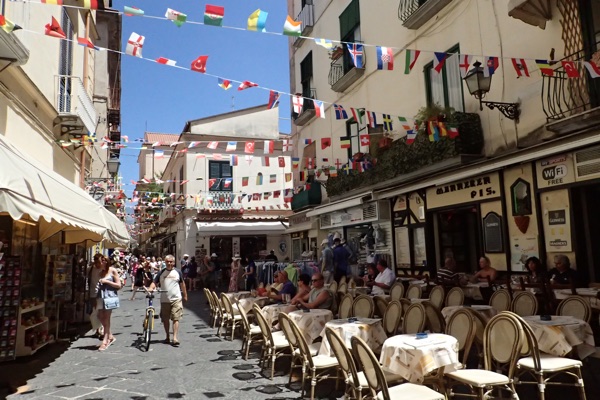
We stopped and had lunch at a fabulous rooftop garden restaurant before having a short wander around town. AuntyMary ordered the ENTREE sized antipasto (it was enormous!), and we had a seafood risotto and some cannelloni all to share. Absolutely delicious.



‘Ciao bella! Want to see my scoot?’ *wink* #WorstPickUpLineEver #PreHashTag All the ceramics – and there were plenty of stores just like this one…!
All the ceramics – and there were plenty of stores just like this one…!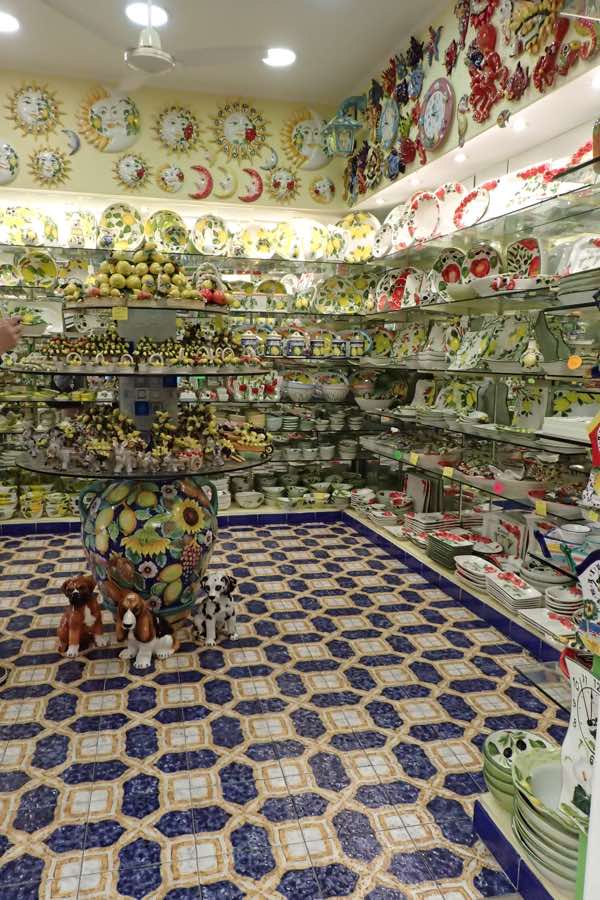


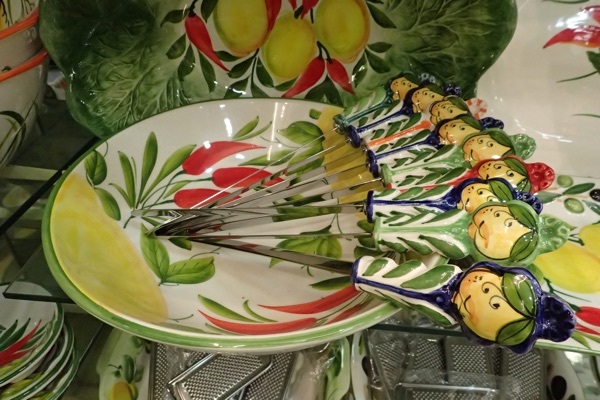
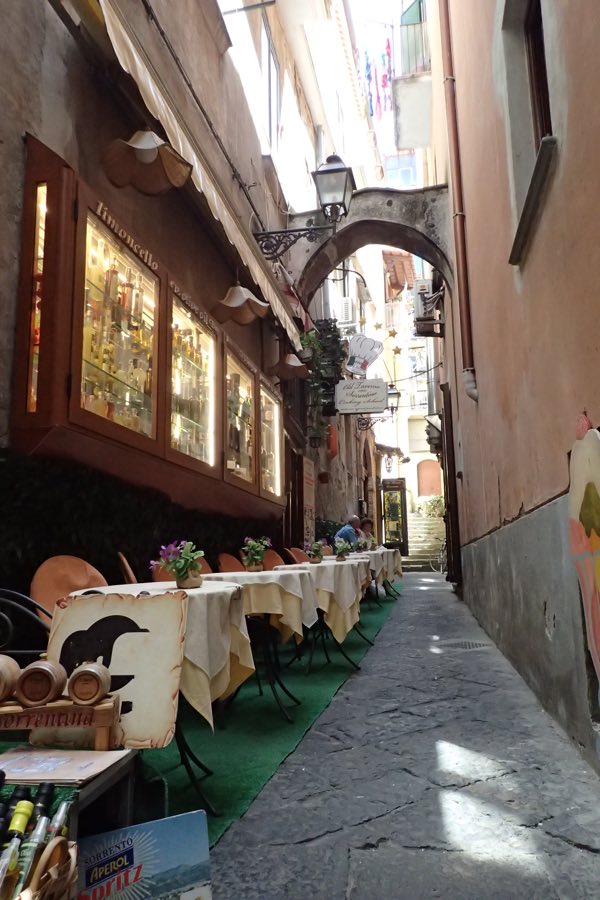 Oh and did we mention the lemons?
Oh and did we mention the lemons?  Sorrento; where even the graffiti is sweet…
Sorrento; where even the graffiti is sweet…
After leaving Sorrento, we followed along the Amalfi coastline to Positano, for more hair raising twisting and turning mountainous roads with stunning views of the sea. The colour of the water in this part of the world is simply beautiful.
 You can see the road winding along the edge of the cliff. Our driver obviously knew the area very well, and was confidently cutting back and forth on the hairpins. There was more than one passenger feeling a little nervy about the drive though!
You can see the road winding along the edge of the cliff. Our driver obviously knew the area very well, and was confidently cutting back and forth on the hairpins. There was more than one passenger feeling a little nervy about the drive though! The bay at Positano.
The bay at Positano. 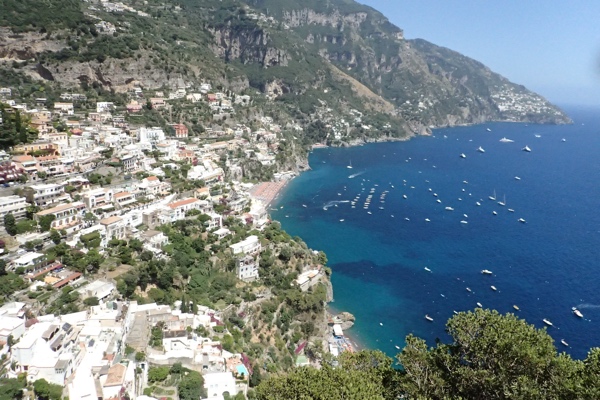 Positano is a bit of crazy town. It’s another ‘playground for the rich and famous’ type of place, and attracts many visitors every year – in fact, I feel many more than the little town can comfortably accommodate It’s perched on? hanging off? the cliffs with crazy meandering little streets all leading down towards the beach. It’s full of art galleries, jewellery stores, resort style clothing and of course – FOOD. So many cafes and restaurants and all designed to best maximise the view.
Positano is a bit of crazy town. It’s another ‘playground for the rich and famous’ type of place, and attracts many visitors every year – in fact, I feel many more than the little town can comfortably accommodate It’s perched on? hanging off? the cliffs with crazy meandering little streets all leading down towards the beach. It’s full of art galleries, jewellery stores, resort style clothing and of course – FOOD. So many cafes and restaurants and all designed to best maximise the view.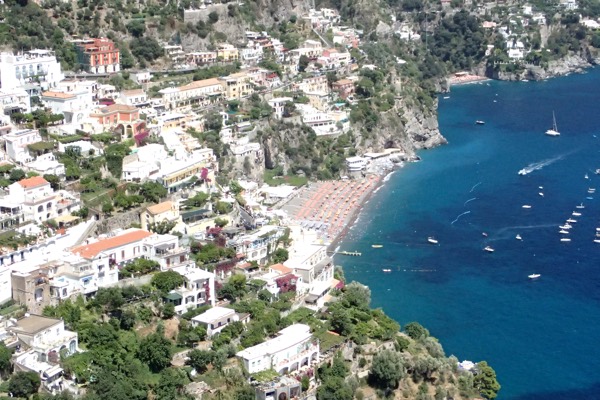
 Wonder what real estate goes for in this area? Mind you, not sure I’d ever want to live here, the beaches are all pebbles, there’s no where to park and everywhere there are soooo many steps and steep roads to the water.
Wonder what real estate goes for in this area? Mind you, not sure I’d ever want to live here, the beaches are all pebbles, there’s no where to park and everywhere there are soooo many steps and steep roads to the water. All the towns along the Amalfi cost have their own nativity to the Santa Maria to keep them safe…
All the towns along the Amalfi cost have their own nativity to the Santa Maria to keep them safe…  Such a cute town, and such a building challenge I should imagine!
Such a cute town, and such a building challenge I should imagine!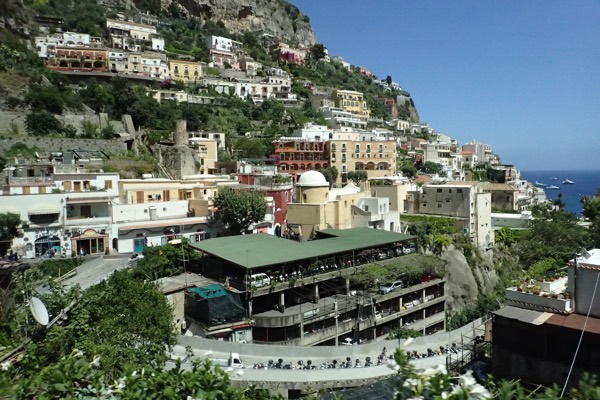




 The amphitheater of Pompeii was primarily used for musical productions. With excellent acoustics, this theatre held about 2000 people.
The amphitheater of Pompeii was primarily used for musical productions. With excellent acoustics, this theatre held about 2000 people.

 Pots where food would be stored and kept warm to sell to workers and passers-by.
Pots where food would be stored and kept warm to sell to workers and passers-by. Walled edge of the amphitheatre directly opposite the ‘fast food’ store.
Walled edge of the amphitheatre directly opposite the ‘fast food’ store. Typical Roman house. This house however had a few more bits of information that tells us something about its inhabitants. The large plinth doorway tells us the inhabitants were quite well off. The seats outside the house tell us that this is apparently a politicians house – people would come to meet and air their grievances and concerns with the local politician and would wait their turn in the street.
Typical Roman house. This house however had a few more bits of information that tells us something about its inhabitants. The large plinth doorway tells us the inhabitants were quite well off. The seats outside the house tell us that this is apparently a politicians house – people would come to meet and air their grievances and concerns with the local politician and would wait their turn in the street. Further evidencing this as the home of a politician was this little piece of propaganda. As it turns out, Pompeii was in the middle of an election period when the volcano erupted, and a good deal of electoral propaganda can be found on the walls. This sign is telling citizens to vote for “Cornelivm”, the man who owns the house above.
Further evidencing this as the home of a politician was this little piece of propaganda. As it turns out, Pompeii was in the middle of an election period when the volcano erupted, and a good deal of electoral propaganda can be found on the walls. This sign is telling citizens to vote for “Cornelivm”, the man who owns the house above.  A little further down the street is the House of Menandro. This is a very well preserved example of a wealthy Roman’s home. The entry foyer/lobby has the typical water feature and open roof, designed to create a type of evaporative cooling system, and to catch water from the opening in the roof for a pretty indoor water feature. Off this room would be all the bedrooms for the inhabitants of the house.
A little further down the street is the House of Menandro. This is a very well preserved example of a wealthy Roman’s home. The entry foyer/lobby has the typical water feature and open roof, designed to create a type of evaporative cooling system, and to catch water from the opening in the roof for a pretty indoor water feature. Off this room would be all the bedrooms for the inhabitants of the house. The frescos are just remarkable – nearly 2000 years old and still quite vivid. Pompeian Red is a thing because of these frescos. The blue colour is apparently the most expensive colour to paint your wall with as it was made with ground lapis.
The frescos are just remarkable – nearly 2000 years old and still quite vivid. Pompeian Red is a thing because of these frescos. The blue colour is apparently the most expensive colour to paint your wall with as it was made with ground lapis. The detail is beautiful – it makes me feel we have lost something in the art of interior decor in the modern era…
The detail is beautiful – it makes me feel we have lost something in the art of interior decor in the modern era…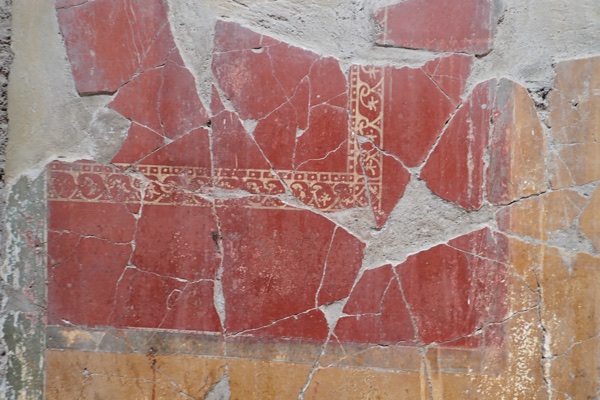 Further through the house are rooms that would have been used for business, for entertaining, for visitors, for cooking, slave quarters – an entire complex to house a Roman household.
Further through the house are rooms that would have been used for business, for entertaining, for visitors, for cooking, slave quarters – an entire complex to house a Roman household. The central garden courtyard is further back in the house, behind the central fountained lobby and bedrooms.
The central garden courtyard is further back in the house, behind the central fountained lobby and bedrooms.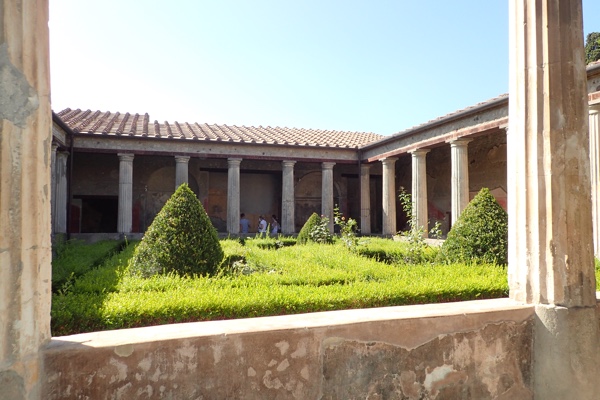
 Most Roman homes did not have a private bathhouse, but this home did. It has a small frigidarium and tepidarium for the wealthy nobles who lived here.
Most Roman homes did not have a private bathhouse, but this home did. It has a small frigidarium and tepidarium for the wealthy nobles who lived here. Bathhouse.
Bathhouse.  I am certain this house is not the only example, but the owners of this house fled the volcano – whether they survived or not is unknown… what is known is that they locked all their wealth and goods into rooms with their slaves to protect them. The slaves in their desperation smashed down the walls in an attempt to escape, but were likely too late to get away. Ash rained down on Pompeii for two days, but the people here had no idea what was happening or how long it would last. At the end of it, the entire city was covered and considered lost.
I am certain this house is not the only example, but the owners of this house fled the volcano – whether they survived or not is unknown… what is known is that they locked all their wealth and goods into rooms with their slaves to protect them. The slaves in their desperation smashed down the walls in an attempt to escape, but were likely too late to get away. Ash rained down on Pompeii for two days, but the people here had no idea what was happening or how long it would last. At the end of it, the entire city was covered and considered lost.
 We went for a walk up the top of a small hill to have a view over the city. Here we got to see the winding streets and how tightly packed the city was.
We went for a walk up the top of a small hill to have a view over the city. Here we got to see the winding streets and how tightly packed the city was. The view down over the streets was from an elevated position, which we later found out is an un-excavated part of the city. We were standing on top of more ancient Roman ruins that it has been decided to leave buried for future generations. You see, due to Mt Vesuvius’ close proximity comes an awareness that it will erupt again one day. And everything that has been excavated could be destroyed. Again. So they have left a large section sealed as it were for after that eventuation.
The view down over the streets was from an elevated position, which we later found out is an un-excavated part of the city. We were standing on top of more ancient Roman ruins that it has been decided to leave buried for future generations. You see, due to Mt Vesuvius’ close proximity comes an awareness that it will erupt again one day. And everything that has been excavated could be destroyed. Again. So they have left a large section sealed as it were for after that eventuation.
 All the roads, walls and monuments and frescos in Pompeii are authentic ancient monuments, but there are artworks dotted throughout the city that are modern bronze works based on impressions of Pompeii. There were a few (the large faces etc) in some of the pictures above as well.
All the roads, walls and monuments and frescos in Pompeii are authentic ancient monuments, but there are artworks dotted throughout the city that are modern bronze works based on impressions of Pompeii. There were a few (the large faces etc) in some of the pictures above as well. This area is the entrance walkways to the public gymnasium, which leads through to a public bath house. More beautiful frescoes line the walkway.
This area is the entrance walkways to the public gymnasium, which leads through to a public bath house. More beautiful frescoes line the walkway. Inside the entry to the bathhouse has the most incredible ceiling, with very fine bas relief styled work. It’s very intricate and would have been stunningly colourful.
Inside the entry to the bathhouse has the most incredible ceiling, with very fine bas relief styled work. It’s very intricate and would have been stunningly colourful. 
 Detail of the ceiling – just gorgeous.
Detail of the ceiling – just gorgeous.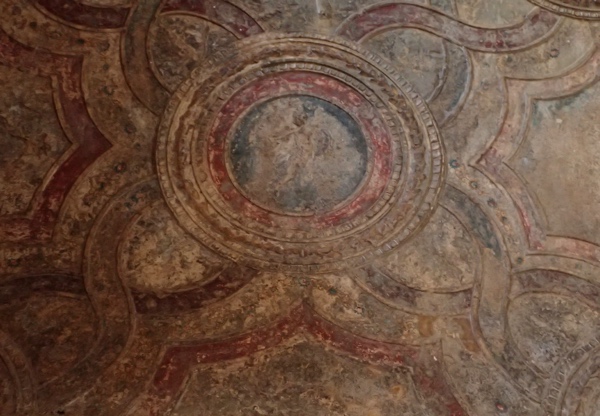 This room is the frigidarium for this bath house. It was for men only. People used the bath houses much like a steam, a hot bath and then a cold plunge at the end to refresh the body and close the pores of the skin… however, it was felt women didn’t have a strong enough constitution for such things, so they were not permitted to use the frigidarium room. The frigidarium roof:
This room is the frigidarium for this bath house. It was for men only. People used the bath houses much like a steam, a hot bath and then a cold plunge at the end to refresh the body and close the pores of the skin… however, it was felt women didn’t have a strong enough constitution for such things, so they were not permitted to use the frigidarium room. The frigidarium roof: The walls of the frigidarium:
The walls of the frigidarium: And the pool of the frigidarium:
And the pool of the frigidarium: The other ares of the bath house were two hot bath house room – one tepid, one really hot…
The other ares of the bath house were two hot bath house room – one tepid, one really hot…
 Back outside in the main square of Pompeii with Mt Vesuvius in the background.
Back outside in the main square of Pompeii with Mt Vesuvius in the background.
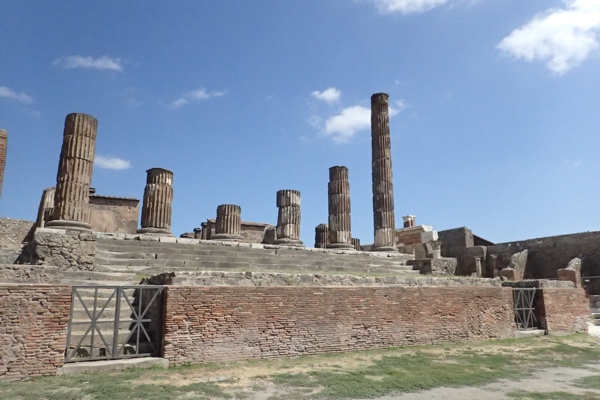 Along the left of the square is a large ‘warehouse’ that is open to the elements. It houses many of the ancient artefacts that won’t fit in the Napoli Archeological Pompeii Museum! All these items are authentic Roman artefacts found in Pompeii. Tables, jars and amphorae that held olive oil, wine, that weird fishy paste/sauce (garram? arum?) that Romans were fond of.
Along the left of the square is a large ‘warehouse’ that is open to the elements. It houses many of the ancient artefacts that won’t fit in the Napoli Archeological Pompeii Museum! All these items are authentic Roman artefacts found in Pompeii. Tables, jars and amphorae that held olive oil, wine, that weird fishy paste/sauce (garram? arum?) that Romans were fond of.

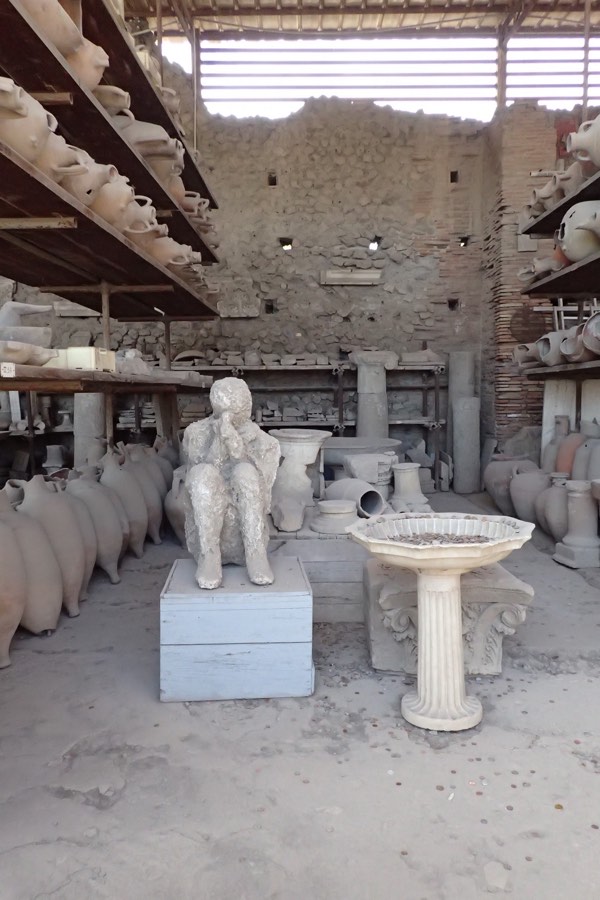 During the excavations of Pompeii, a particularly cluey archeologist discovered that they were unearthing ‘bubbles’ or cavities in the ash that occasionally had human remains in them. These cavities turned out to be where humans had been caught in the ash and had died, and subsequently decomposed. The archeologist (whose name I can’t remember) decided to pour plaster paris into the cavities to see what they were and discovered people, frozen at the time of their deaths. Most of these casts are now in the museum and are being tested for DNA to find out more about the people who died in Pompeii.
During the excavations of Pompeii, a particularly cluey archeologist discovered that they were unearthing ‘bubbles’ or cavities in the ash that occasionally had human remains in them. These cavities turned out to be where humans had been caught in the ash and had died, and subsequently decomposed. The archeologist (whose name I can’t remember) decided to pour plaster paris into the cavities to see what they were and discovered people, frozen at the time of their deaths. Most of these casts are now in the museum and are being tested for DNA to find out more about the people who died in Pompeii. And then it seemed we were leaving our tour. With a few of us having been here before, we asked the guide if we were going to the red light district, as attitudes to life, love, sex, and death were very different in ancient times and it’s interesting to see how the Romans’ views differed from our modern views. Our guide, Monica, claims was told by her company that we were not going to the brothels as part of our tour of Pompeii. We asked amongst ourselves and none of us had give that directive, so it seem she had taken it upon herself to censor our tour, possibly because we had four teenagers travelling with us. So suddenly we didn’t have time to go to the brothels at all. Bit disappointed for the others, but having been through them before, I was not too bothered. She did walk us back down a street we had already taken to show us a sign that pointed to the red light district (can’t believe we walked right past it and she didn’t point it out… bit prudish).
And then it seemed we were leaving our tour. With a few of us having been here before, we asked the guide if we were going to the red light district, as attitudes to life, love, sex, and death were very different in ancient times and it’s interesting to see how the Romans’ views differed from our modern views. Our guide, Monica, claims was told by her company that we were not going to the brothels as part of our tour of Pompeii. We asked amongst ourselves and none of us had give that directive, so it seem she had taken it upon herself to censor our tour, possibly because we had four teenagers travelling with us. So suddenly we didn’t have time to go to the brothels at all. Bit disappointed for the others, but having been through them before, I was not too bothered. She did walk us back down a street we had already taken to show us a sign that pointed to the red light district (can’t believe we walked right past it and she didn’t point it out… bit prudish). 
 The view from Taverna dell’Etna
The view from Taverna dell’Etna The restaurant itself didn’t exactly have the most sophisticated decor, but then that is often the case with little hidden gem restaurants! It was late afternoon by the time we got there for lunch, but they were kind enough to stay open. We were so hungry, would you believe – I don’t think anyone took even so much as a single photo of the food!
The restaurant itself didn’t exactly have the most sophisticated decor, but then that is often the case with little hidden gem restaurants! It was late afternoon by the time we got there for lunch, but they were kind enough to stay open. We were so hungry, would you believe – I don’t think anyone took even so much as a single photo of the food!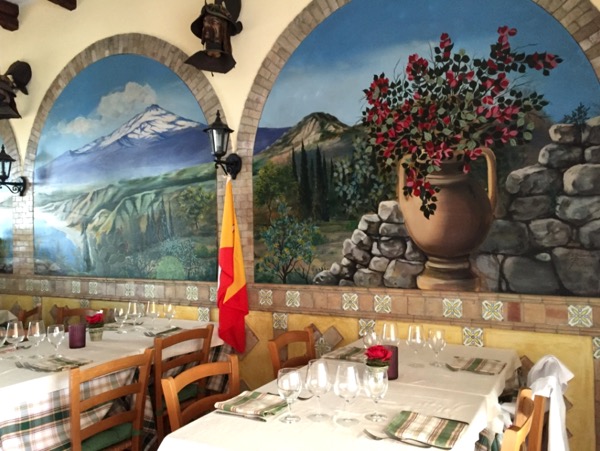
 Views down to Naxos Bay.
Views down to Naxos Bay.
 Taormina evidences both Greek and Roman history in its architectural style, as well as a significant medieval quarter with castle ruins intermingled with modern shops and restaurants, known as the Corso Umberto.
Taormina evidences both Greek and Roman history in its architectural style, as well as a significant medieval quarter with castle ruins intermingled with modern shops and restaurants, known as the Corso Umberto.

 Lots of higher end shopping in this town, but the only thing any of us bought was gelato and later, more wine!
Lots of higher end shopping in this town, but the only thing any of us bought was gelato and later, more wine! View from the Hotel Metropole…
View from the Hotel Metropole…

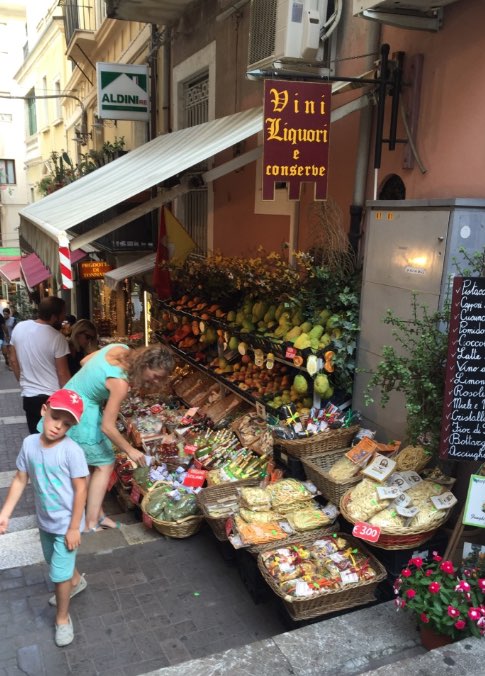



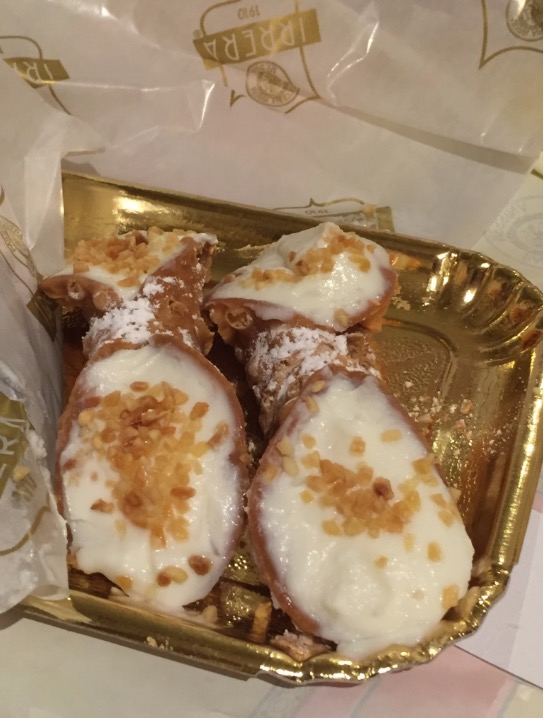





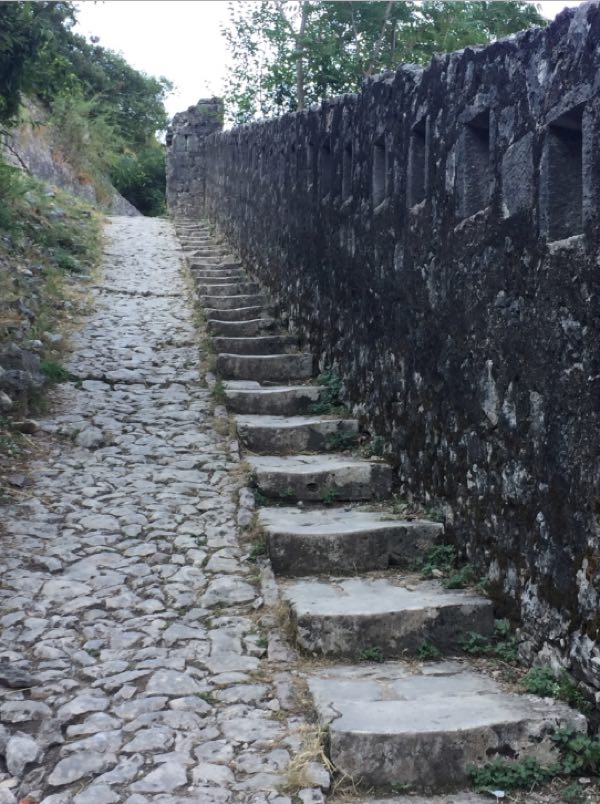 Some of our group decided to walk the fortress walls – got up there early before the heat (wise move it was seriously hot today), and they took the 1200 uneven cobbled steps involved to do the 4.5km walk around the fortress walls.
Some of our group decided to walk the fortress walls – got up there early before the heat (wise move it was seriously hot today), and they took the 1200 uneven cobbled steps involved to do the 4.5km walk around the fortress walls. Kotor Inlet… the entire inlet is surrounded by the Montenegrian mountain range which rings the bay. It very effectively stifles any sea breezes from making it into the town. Add to that, the fact that the town is entirely walled, and you have one big hot box. The place if gorgeous, but it was almost unanimously agreed, that it would be twice as beautiful in shoulder season when you weren’t walking around in 35C heat without so much as a whiff of breeze to refresh you.
Kotor Inlet… the entire inlet is surrounded by the Montenegrian mountain range which rings the bay. It very effectively stifles any sea breezes from making it into the town. Add to that, the fact that the town is entirely walled, and you have one big hot box. The place if gorgeous, but it was almost unanimously agreed, that it would be twice as beautiful in shoulder season when you weren’t walking around in 35C heat without so much as a whiff of breeze to refresh you.

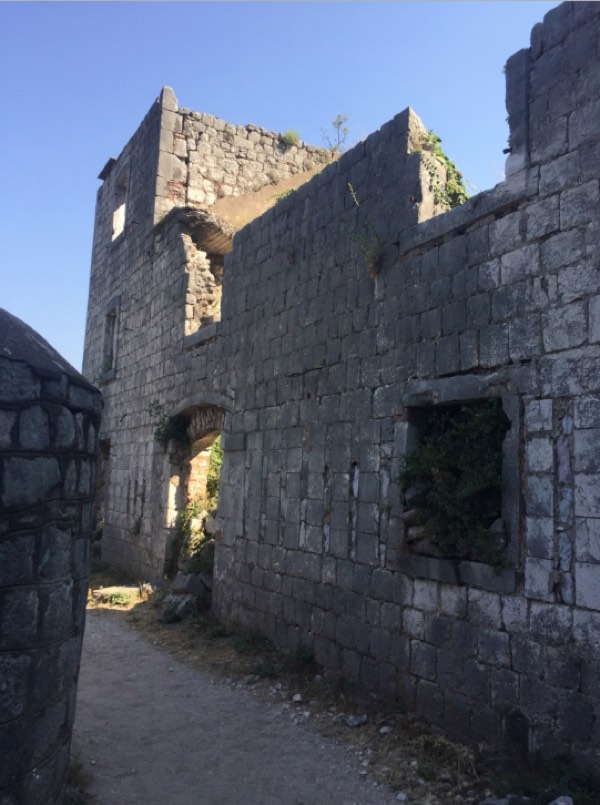 View over the rooftops from the top of the fortress.
View over the rooftops from the top of the fortress.



 There was no English guide or plaques telling us what we were looking at, but most of the artefacts are 12th-16th century… so we had to wing it a little.
There was no English guide or plaques telling us what we were looking at, but most of the artefacts are 12th-16th century… so we had to wing it a little. Medieval saintly reliquaries of God-Knows-Who from God-Knows-Where. :/
Medieval saintly reliquaries of God-Knows-Who from God-Knows-Where. :/  Very cool plaque belt/girdle? Loved the work in it so photographed the lot. Rough guess 1300s-1500s… though my jeweller friends might have a better stab at that.
Very cool plaque belt/girdle? Loved the work in it so photographed the lot. Rough guess 1300s-1500s… though my jeweller friends might have a better stab at that.




 Lots of meandering little back alleys.
Lots of meandering little back alleys. We found ourselves delayed leaving port due to a medical emergency, which we later found out was the result of a passenger falling between the ship and a tender boat when embarking the ship. Apparently the poor guy fell and was crushed, resulting in a broken leg and possibly some broken ribs. I hope he’s okay, and I hope Princess look after him and his family.
We found ourselves delayed leaving port due to a medical emergency, which we later found out was the result of a passenger falling between the ship and a tender boat when embarking the ship. Apparently the poor guy fell and was crushed, resulting in a broken leg and possibly some broken ribs. I hope he’s okay, and I hope Princess look after him and his family.


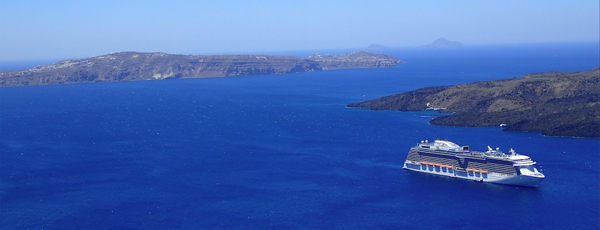 Three options to get to the town of Fira – 1) by cable car, 2) walk up the windy path to the top, and 3) take a dodgy donkey ride. Most of our group opted for donkey, and lots of fun was had. We were considering walking down, but the smell of donkey shit in the heat is not for the faint hearted!
Three options to get to the town of Fira – 1) by cable car, 2) walk up the windy path to the top, and 3) take a dodgy donkey ride. Most of our group opted for donkey, and lots of fun was had. We were considering walking down, but the smell of donkey shit in the heat is not for the faint hearted! And then when you get to the top – it’s all just so picturesque.
And then when you get to the top – it’s all just so picturesque.





 This is not painted on – all appearances to the contrary!
This is not painted on – all appearances to the contrary!






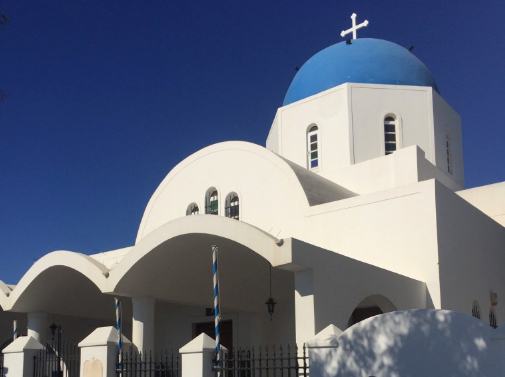
 Tomorrow – a much needed sea day…
Tomorrow – a much needed sea day…